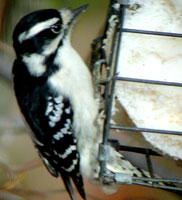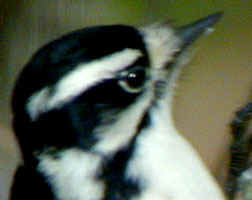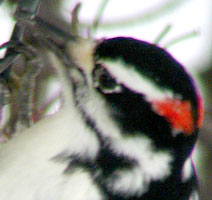 Variation in the head patterns of Downy (Picoides pubescens) and
Hairy (P. villosus) woodpeckers.
Variation in the head patterns of Downy (Picoides pubescens) and
Hairy (P. villosus) woodpeckers. Variation in the head patterns of Downy (Picoides pubescens) and
Hairy (P. villosus) woodpeckers.
Variation in the head patterns of Downy (Picoides pubescens) and
Hairy (P. villosus) woodpeckers.
All photographs © Kevin and Jay McGowan, unless otherwise noted.
Male and female Downy and Hairy woodpeckers show different patterns on the back of their heads, with males having red feathers and females lacking the red. What is not as well appreciated is that a great deal of variation exists among the individuals within a sex too.
All individuals are unique in some way. Variation can be subtle and difficult to quantify, but occasionally it is clearly "black and white." I recently asked the question, "Do female Downy Woodpeckers have black at the back of the head separating their white eyestripes, or not?" When I went to our photographs to check, I found out the answer is "Yes, and no." This seems like a pretty basic plumage character, but birds vary in surprising ways.
The following are photographs taken in our yard south of Dryden, Tompkins Co., NY. Some may be multiple photographs of the same individual, but others clearly are not.
 Fig. 1. This female, photographed 25 February 2001, shows a clear white band extending completely around the head. |
 Fig. 2. This female, photographed 9 April 2002, shows a complete white band. Is this the same individual as Fig. 1?
|
|
 Fig. 3. This female, photographed 5 November 2000, has a large black stripe separating the white eyelines.
|
 Fig. 4. This may or may not be the same female as in Fig. 3, but the black divider seems narrower. Taken 23 May 2000.
|
|
 Fig. 5. This shot, taken 8 October 2000, clearly shows the extent of black on the back of the head. This is probably the same female as in Fig. 3. |
||
|
Males vary in their head patterns too. They vary in the extent of the red, but also in the underlying black and white too. |
||
 Fig. 6. This male, taken 5 November 2000, shows a large amount of white above the red patch. Or is it that the red patch is just small? It is obvious from this shot that if the red wasn't there the white would be continuous around the back of the head.
|
 Fig. 7. This male, taken 9 January 2002, has a more extensive red patch that extends up to and onto the black cap, and also farther onto the white supercilium.
|
|
 Fig. 8. This male, photographed 19 March 2000, shows a similarly-sized red patch to the male in Fig. 7., but also has a white spot on the top of its head.
|
||
|
What may not be appreciated is that the red feathers on a male's head are not entirely red. In fact, only the tips of the feathers are red. Just behind the red, the feathers show either black or white in the same pattern as the female's markings. |
||
 Fig. 9. This male struck our window on 12 December 2002. It appears at first glance to have a nice red patch, but if you look closely you'll see that the red patch actually contains some black. Imagine that the red was just painted over the white and black feathers, and you can see a black dividing line down the middle. The red is darkest right in the middle, and lighter off on the sides.
|
 Fig. 10. This view of the same male as in Fig. 9, on 12 December 2002, shows the red-tipping to the feathers, as well as black extending down into the "white" zone. Without the red, this bird probably would have a black division between the white eyestripes.
|
|
 Fig. 11. This male, photographed 9 October 2002 outside of our yard, but in the same area, shows the red-tipping pretty well (even if it is a lousy shot otherwise.)
|
 Fig. 12. This bird, photographed 1 September 2001, shows the same kind of mottled markings with very limited red as Fig. 11. Note the stray red feathers farther down the nape in the thick black patch. |
|
| I do not think the limited red on the heads of these two individuals is the result of their age. Juveniles have somewhat limited red, but it is confined to the crown and forward to the eyes, not on the back of the head (and juvenile females have some red too!). | ||
It has been suggested that Hairy Woodpeckers have thick black lines through the red on the back of their head, while Downy Woodpeckers lack the black. Unfortunately, I do not have enough photographs to confirm or refute this idea. It does appear that the red on male Hairys is more restricted, but I would use this character as an indicator of species only, and not as confirmation.
 Fig. 13. This male Hairy, photographed 6 January 2001, shows a clear black division down the red. The red seems confined to the tips of the white feathers only. |
 Fig. 14. This female Hairy, photographed on 8 February 2003, shows a black dividing line at the back of the eyestripe. |
I did not realize we had so few decent Hairy Woodpecker photos (at least of the backs of their heads). Watch this space for more photos in the future.
Return to the Bad Photos page.
Return to Kevin McGowan's home page.
Go to the Crow Page.
Go to the Cornell Lab of Ornithology's home page